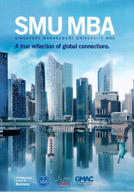
In today's business landscape, successful innovation and growth are often reliant on strong product development collaborations. However, for such joint ventures to be effective, it's important to manage them in a way that extracts the most value possible.
Research and development (R&D) collaborations are common in various industries. Still, they involve numerous stakeholders and can be challenging to manage, particularly in pharmaceutical biotech sectors where there are several technical and market risks as well as incentive problems. As such, licensing contracts are critical in R&D collaborations: They define the rights and responsibilities of each party involved in the partnership. In particular, licensing agreements can help ensure that both parties benefit from the collaboration.
The research paper, Licensing Contracts: Control Rights, Options and Timing, co-authored by the Dean of SMU Lee Kong Chian School of Business, Professor Bert De Reyck, and SMU Professor of Operations Management Pascale Crama and their colleague, Dr Niyazi Taneri at Judge Business School (Cambridge UK), explores how different strategies can help create greater value for innovators willing to share their creations with marketers. These key components include timing — caused by renegotiation or delayed contracting- and the careful allocation of control rights and options that can influence the value of collaborative R&D.
By modelling a combination of contract payments, the allocation of control rights and options, and timing decisions, Professor De Reyck, Professor Crama and their co-authors show that carefully crafting licensing contracts is critical for maximising results. Notably, the team emerged as a runner-up at the 2022 INFORMS TIMES Best Paper Award, which recognises impactful papers in technology management, innovation, and entrepreneurship.
Key drivers of contracting decisions
Managing R&D projects and partnerships can be a major challenge, due to the various uncertainties inherent in these endeavours. In particular, there is no guarantee of success when bringing new products to market, nor can we predict how well they will be received by consumers or what impact they will have on market value. Moreover, even if a product is successfully launched and gains some traction in the market, there is always uncertainty surrounding future developments and possible market conditions that could result in unforeseen fluctuations in profitability.
One of the forces driving contracting choices is whether the R&D partnership involves a novel process created specifically to address a specific need or solve a certain problem; or an incremental process, which builds upon an existing method by making minor improvements or modifications.
Generally speaking, novel processes are more expensive and time-consuming than incremental ones. This is because they require more R&D to figure out how best to address the needs or solve the problems they are designed to address. Incremental processes, by contrast, can be developed relatively quickly and affordably since they are based on already-existing knowledge and technology.
Depending on the R&D process required, stakeholders can then determine whether payment terms are adequate for maximum efficiency and results.
Moreover, there is no one guaranteed outcome in any market. Each market has unique potential outcomes, determined by the interactions of all the buyers and sellers in that market.
This unpredictability is what makes markets so fascinating — it's always possible for something new and unexpected to happen, which can lead to huge profits (or losses) for those who can anticipate and capitalise on these fluctuations. Hence, stakeholders often consider the variability of market-potential outcomes regarding licensing contracts.
Finding the right contract
A well-constructed contract is a vital tool for protecting the interests of all stakeholders in an R&D project. By setting out the expectations and responsibilities of all parties involved, a contract can help avoid misunderstandings and disputes that could disrupt the project.
For example, an exclusion contract — in which one party agrees to release the other party from all claims and liabilities, can be applied to incremental products with high variability in market-potential outcomes. Its terms “limit distortion to marketing and R&D efforts and suffer a comparatively mild loss due to innovator launch in the low market-potential outcome”.
On the other hand, a buy-out contract is an agreement between two parties in which one party agrees to purchase the other party's business or operations. The purpose of a buy-out contract is to provide a means for the selling party to exit their business while providing some protection for the buyer in case the business fails after the purchase. Besides an exclusion contract, a buy-out agreement might apply to novel innovations with high market-potential variability because they require payment terms that are more responsive to a market outcome.
Finally, incremental products with low variability may benefit from delaying contracting or by renegotiating an upfront contract to avoid costly marketing efforts or launch allocation distortions. Launch allocation is when a company determines which products or services to offer its customers and when to make them available. It can be thought of as a product's launch strategy, and typically involves making decisions about how much of the product to produce, what market segment(s) to target, what pricing approach to use, and how much marketing support to provide.
Giving up rights for a better outcome
Besides shedding light on the best types of contracts for R&D licenses, the award-winning study reveals a counterintuitive result: the innovator may prefer to grant launch control rights or buy-out options to the marketer even though both terms restrict its downstream actions — that is, the steps that are taken after a company has decided on the product it wishes to develop.
For example, an exclusion contract transfers launch control rights to the marketer, thereby incentivising innovators to ramp up R&D efforts to achieve a higher market-potential outcome. An innovator may also be motivated to elevate their R&D efforts if the contract allows a marketer to buy them out when the project achieves high market potential.
“While the benefits of holding an option are well understood, this shows that giving away an option can also be valuable,” adds Professor De Reyck and Professor Crama.
As various industries continue to grow amid rapid digital transformation and innovation, companies are increasingly looking to establish R&D partnerships for greater efficiency and expertise to bring products to market. To remain competitive in today's marketplace, it is essential for firms to build strong relationships with their peers and collaborate on ground-breaking projects. With so much at stake, Professor De Reyck and Professor Crama’s research yields insights into the optimisation of R&D contracts and shapes the future of the innovation landscape.
Speak to our Admissions Advisors
Singapore Management University
Lee Kong Chian School of Business
Graduate Programmes Office, Level 4
50 Stamford Road, Singapore 178899
Tel: +65 6828 0882
You may also be interested in
Executive Master of Business Administration (EMBA)
